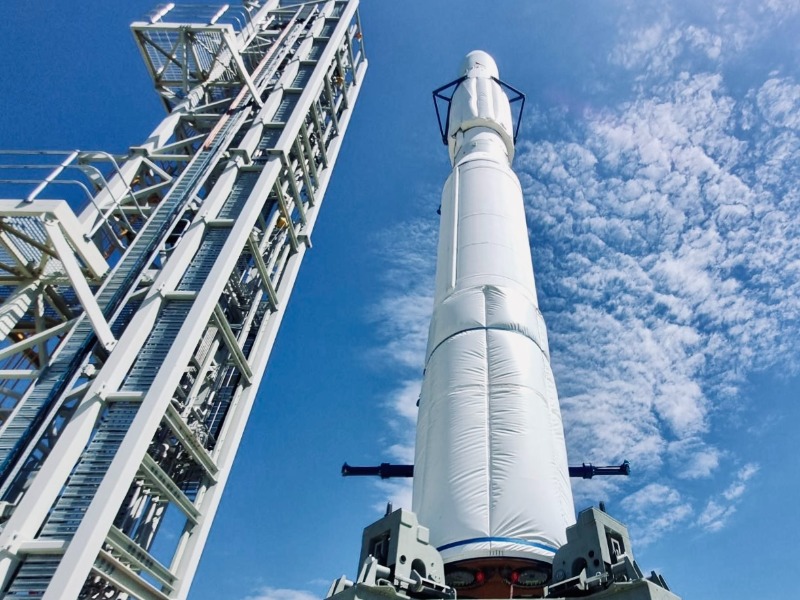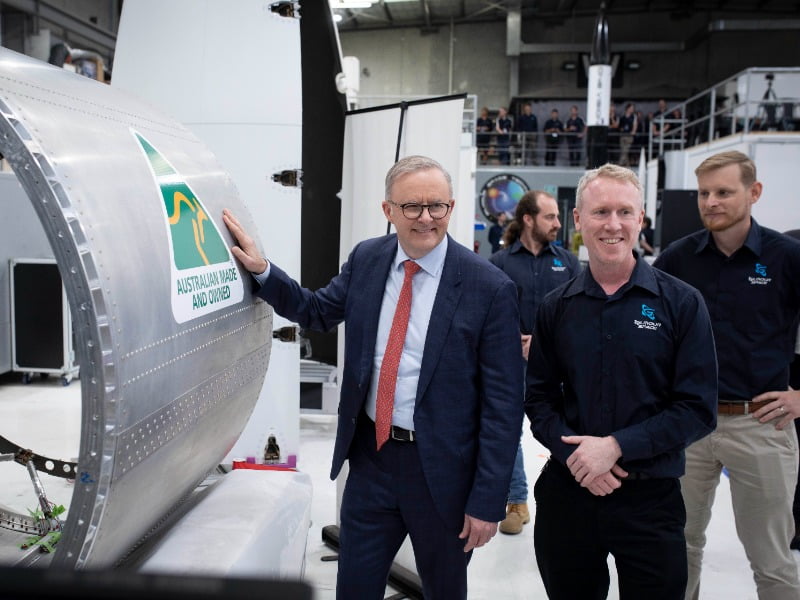Gilmour Space Technologies has completed the final wet-test of its Eris orbital rocket and pending final documentation from the Civil Aviation Safety Authority, expects to nominate a launch for mid- to late January.
The company completed the final wet test last weekend in which all liquid oxidisers were loaded onto the vehicle under full countdown dress rehearsal conditions.
Gilmour Space founder and chief executive Adam Gilmour said the process had left the team confident and ready to go, having addressed specific issues related to valves in the rocket’s hydrogen peroxide delivery system that had been discovered in an earlier wet test.
After a busy few months, the company will now break for the holidays, Mr Gilmour said, with many of the team from both the Bowen Orbital Spaceport and the Gilmour manufacturing facility on the Gold Coast taking two weeks off to recharge and reset ahead of the intense work of the January launch period.
The final dress rehearsal had given the team a lot more confidence in the launch vehicle, he said.
“In the last wet test, we found some errors. We found problems with [some] valves, and so we had to pull the rocket apart, re-test all the valves and put new ones in,” Mr Gilmour said.
“And that’s what we have tested in this last wet test. And it’s worked all very well.”

The fix, although a lot of work, was relatively quick. The company had spare valves on hand that had already been prepared in readiness for its second and third rockets.
“We put them through a more rigorous testing process, simulated the failure mechanism that we saw during the first wet dress rehearsal. And then with the ones that passed [the more rigorous testing], we put them back into the rocket,” Mr Gilmour said.
“But we still have to investigate the ones that failed to understand what exactly went on.”
Right now, the company is confident its maiden test flight will be a success – by which he means flight time. The point of the launch is to shoot for orbit. But the company would be satisfied with what would be learned for an extended flight time, at least until its main engine shut down.
The biggest contingent risk for the maiden flight is the fact that the four engines on the stage one of the rocket have never been test-fired together. This presents some challenges on launch day.
The Eris launch vehicle stage one is powered by four Gilmour designed and manufactured Sirius hybrid rocket engines. Stage two of Eris is powered by a single Sirius engine, while stage three is fired by Gilmour’s liquid-fueled Pheonix engine.
The four Sirius engines will only be fired simultaneously, in combination, on its first flight.
Mr Gilmour says when the rockets power-up at launch, the team will have just a few seconds to understand that each engine is operating at its optimal performance and calibrated to the performance of each of the other engines.
The Eris vehicle is held down by giant hydraulic clamps at ignition – and the team uses those few seconds decides whether to proceed or to shut down the feeds of liquid oxidiser into the system, which would shut down the engines.
Its one of the known unknowns of the maiden flight.
“We haven’t test fired all four engines together in a pack. We’ve got a process to test them right at the [start of the] launch for a number of seconds to make sure they’re okay, while the vehicle is still being held down,” Mr Gilmour said.
“There is a risk that something goes wrong then, and we just abort so that the rocket won’t be destroyed. But if all the engines fire with a certain amount of thrust each, then we will let it go,” he said.
“And once we let it go, we’re very confident that it should go all the way to – at least – main engine cut-off.
“Because we have done all the wet testing, all the tests of systems that we’ll be needing when it’s in flight, we have gained a lot of confidence in the vehicle,” Mr Gilmour said.
“But really you never know. You can drive a car 100 times and then on the 101st and first time, something goes wrong.
“But we’ve managed to now test successfully all the major systems that we need to get good flight time out of the rocket, except for hot firing all four engines at once – that’s something [we have not done].”
Gilmour’s Eris maiden flight will be the first orbital launch from Australian soil in 50 years. And it will be the first ever launch of an Australian-designed and manufactured rocket by a sovereign Australian company.

Reaching orbit is always a possibility, but the likelihood is far from a probable. In the history of orbital flight, no newly-designed vehicle has reached orbit on its first attempt.
For perspective, SpaceX’s original Falcon vehicle successfully reached orbit on its fourth attempt, just as the company teetered on the edge of financial failure.
Adam Gilmour says if the Eris Testflight 1 Mission goes well, the company will go back to the market and raise more money.
“We have got enough money to do two more launches after [Testflight 1]. But we do plan to do a fundraise after this launch, because the investor market is very keen on space again, and there’s a lot more interest coming from customers,” Mr Gilmour said.
“We think it’s a good opportunity. If the launch goes just reasonably well, then we can raise money again.”
“Customers have been waiting for us to do this first launch attempt before they commit. And more and more demand [for launch services] is coming.
“We think we’ve got a really good chance of signing contracts in the months after the first launch attempt. As long as it goes OK. We don’t have to get to orbit, it has to just have some flight time…”
“We’re not going to be able to push much faster than that, and six months will still be pretty sporty. It will be six to eight months because we want to increase the chance of success on the second [test flight], and so we want to see what happens with the first rocket and make modifications [where they are needed].”
The company is well advanced in building its second vehicle, but it will be at least six months after the first before the company would be ready to attempt a second launch.
“We’re not going to be able to push much faster than that. Because we want to increase the chance of success on the second [test flight], we need to see what happens with the first rocket and make modifications [where they are needed].”
Do you know more? Contact James Riley via Email.

